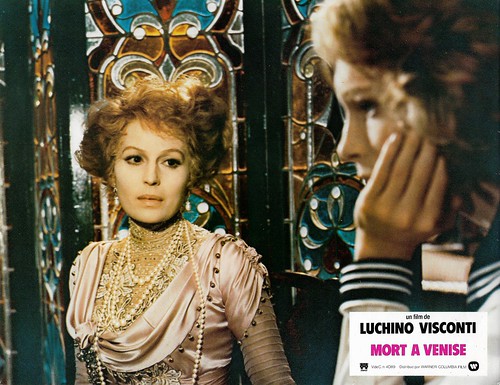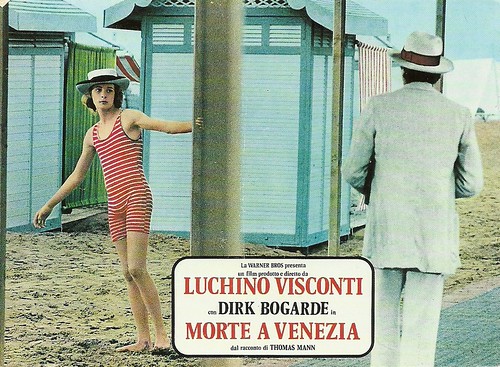
French publicity leaflet. Silvana Mangano and BjörnAndrésen in Morte a Venezia / Death in Venice / Mort à Venise (Luchino Visconti, 1971). Dress designed by Piero Tosi.

Vintage still for Morte a Venezia / Death in Venice (Luchino Visconti, 1971), starring Dirk Bogarde as Gustav von Aschenbach, Björn Andrésen as Tadzio and Nora Ricci as the governess, seen on the back, during the first meeting in the lobby of Hotel des Bains.

Dutch postcard, using the original poster, for a Dutch rerelease of the film. Björn Andrésen and Dirk Bogarde in Morte a Venezia / Death in Venice (Luchino Visconti, 1971).

Vintage still for Morte a Venezia / Death in Venice (Luchino Visconti, 1971). Silvana Mangano as Tadzio's mother in the lobby of Des Bains. Watermark of the Dutch Central Committee for Film Censorship.
The object of attention of older men
Björn Johan Andrésen was born in Stockholm in 1955. Andrésen never knew his father, and his mother, Barbro Elisabeth Andrésen, committed suicide when he was 10. Andrésen attended Adolf Fredrik's Music School in Stockholm. His maternal grandparents raised him and his grandmother encouraged him to do extracurricular work like theatre, motivated by a personal ambition to have a famous grandchild.
Andrésen was 15 (some sources write fourteen) and had only played a small part in one film, En kärlekshistoria / A Swedish Love Story (Roy Andersson, 1970), when he was cast in Morte a Venezia / Death in Venice (Luchino Visconti, 1971). The film brought him worldwide fame.
After a search all over Northern Europe, documented on film in Alla ricerca di Tadzio (1970), Andrésen was chosen by Luchino Visconti to play Tadzio. Tadzio is a beautiful Polish boy with whom the film's older protagonist, Gustav von Aschenbach (Dirk Bogarde), becomes obsessed. The film is situated in Venice, an elite tourist city, gradually falling prey to a cholera plague. Film historian Lawrence J. Quirk commented that some images of Andrésen “could be taken from the film and hung in the halls of the Louvre or the Vatican”.
When the film was released in the United States, rumours circulated that Andrésen was homosexual. In the film, he exchanges glances that could ambiguously be interpreted as romantic with the protagonist. Tadzio is the object of his desire. Andrésen emphatically denied these rumours. In 2003, Björn Andrésen recounted in an interview for The Guardian, attending the film's premiere at the Cannes Film Festival: "I was just 16 and Visconti and the team took me to a gay nightclub. Almost all the crew were gay. The waiters at the club made me feel very uncomfortable. They looked at me uncompromisingly as if I was a nice meaty dish...it was the first of many such encounters".
Visconti himself protected him throughout the production and paid him a one-year contract afterwards. Costume designer Piero Tosi told us once the anecdote that Andrésen had a female Swedish private tutor in order to keep to ensure that he did not fall too far behind at school. However, the two got sexually involved, as a result of which the young ephebe's body started to change.

Vintage lobby card for Morte a Venezia / Death in Venice (Luchino Visconti, 1971), starring Silvana Mangano as Tadzio's mother at Piazza San Marco.

Vintage still for Morte a Venezia / Death in Venice (Luchino Visconti, 1971), with Björn Andrésen as Tadzio and Silvana Mangano as Tadzio's mother in the hotel lobby.

Vintage still for Morte a Venezia / Death in Venice (Luchino Visconti, 1971), the family in the breakfast room, with Björn Andrésen as Tadzio, Silvana Mangano as Tadzio's mother and Nora Ricci as the governess.

Vintage still for Morte a Venezia / Death in Venice (Luchino Visconti, 1971), starring Dirk Bogarde as Gustav von Aschenbach and Björn Andrésen as Tadzio.
Big in Japan
Death in Venice made Björn Andrésen famous overnight. He went to Japan, where his arrival in Tokyo was met with mass hysteria, as if he were a hugely popular pop star. In Japan, he achieved great success as a fashion model, acted in commercials and recorded two pop songs. His commercial activity in Japan cemented his status as a key figure in the popular 'Bishōnen' (beautiful boy) aesthetic. Manga author Riyoko Ikeda was inspired by his face when she created the androgynous character of Lady Oscar.
Andrésen sank into depression and alcohol as a result of the focus on his looks, but he later gained some distance from it all. During the 1980s, he attended drama school in Stockholm. He was also the keyboardist in the dance band Sven-Erics. He became angry when feminist writer Germaine Greer used a photograph of him by David Bailey on the cover of her book 'The Beautiful Boy' (2003) without asking his permission. Eager to dispel rumours about his homosexuality and to shake off his image as a 'pretty boy', Andrésen subsequently avoided gay roles or those he felt would be based solely on his good looks.
Between 1977 and 2021, Andrésen appeared as a supporting actor or cameo player in 22 Scandinavian films and TV series such as Den enfaldige mördaren / The Simple-Minded Murderer (Hans Alfredson, 1982), starring Stellan Skarsgård, Smugglarkungen / The Smuggler King (Sune Lund-Sørensen, 1985), the Finnish fantasy film Pelikaanimies / Pelicanman (Liisa Helminen, 2004), and the TV film Wallander – Arvet / Wallander - The Heritage (2010). Late in life, he finally got a leading role in the little-seen Danish drama The Lost Ones (Dariusz Steiness, 2016). He played Rolf, who is forgotten but still going forward with boundless love and courage. He also played the ageing Dan in the internationally renowned Swedish-American Horror film Midsommar (Ari Aster, 2019), starring Florence Pugh as Dani and Jack Reynor as Christian.
In 2021, the 50th anniversary of Visconti's film, Andrésen returned to the spotlight as the protagonist of the Swedish documentary film Världens vackraste pojke / The Most Beautiful Boy in the World (Kristian Petri, Kristina Lindström, 2021), which was presented at the Sundance Film Festival and awarded the Prix Europa 2022 for best European television documentary. "One good thing is that it has sparked a debate about how children are abused in the film world, which is often grotesquely brutal. You use them and cuddle them, then just throw them to the wolves," said Björn Andrésen in 2021. The documentary stressed his exploitation by other men from Death in Venice onward. However, during a live talk in Amsterdam, when presenting the documentary, Andrésen also admitted that he had had a lot of fun while shooting Death in Venice.
In 1983, Björn Andrésen was married to poet and scriptwriter Suzanna Roman (Susanna Román), but they divorced in 1987. The couple had two children. One of whom died of cot death, which caused Andresen a new depression. He also had two grandchildren. The cause of his death is unknown.

Vintage still for Morte a Venezia / Death in Venice (Luchino Visconti, 1971), with Björn Andrésen and Antonio Apicella.

Vintage still for Morte a Venezia / Death in Venice (Luchino Visconti, 1971), starring Dirk Bogarde as Gustav von Aschenbach, who imagines that he is warning Tadzio's family against the plague (Mangano, Andrésen and Nora Ricci as the governess), at the veranda of Hotel Des Bains.

Vintage still for Morte a Venezia/ Death in Venice (Luchino Visconti, 1971), with Björn Andrésen and Sergio Garfagnoli. Watermark of the Dutch Central Committee for Film Censorship.

Vintage still for Morte a Venezia/ Death in Venice (Luchino Visconti, 1971). The death of Gustav von Aschenbach (Dirk Bogarde).
Sources: Wikipedia (English and Italian), IMDb, the documentary The Most Beautiful Boy in the World and an unpublished interview by Ivo Blom with Piero Tosi.
No comments:
Post a Comment